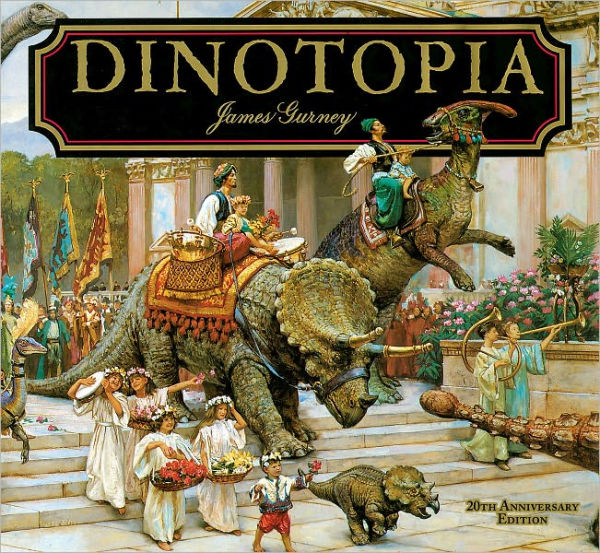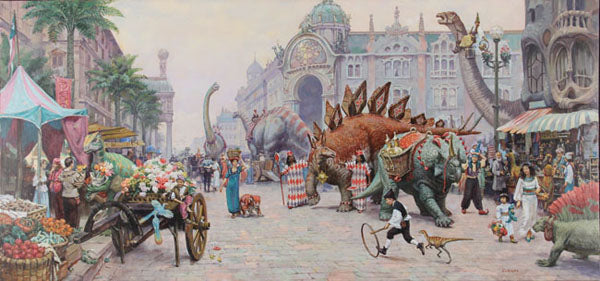Dinosaurs and Dragons (original) (raw)

Dinotopia: A Land Apart from Time, by James Gurney – I seem to remember reading something about this book around when it first came out in the early nineties, in National Geographic or something. I was interested, but I didn’t get around to checking it out until just recently. The illustrations are largely the highlight, being lush and full of detail, mixing various elements together to portray a society where dinosaurs live alongside humans, and technology is often more in accordance with nature.
The story takes place in the 1860s, when a lot of the world was still unexplored and dinosaurs had only recently been discovered. Arthur Denison and his son Will are shipwrecked and taken by dolphins to the titular island, with the narrative and pictures being presented as Arthur’s sketchbook. The dinosaurs are able to communicate with the people, and have their own alphabet based on footprints. There are many different sorts of dinosaurs described and depicted, and we can see how various aspects of this land operate. I noticed that a description of a dung cart described it as being “a more ill-smelling vehicle than any I have encountered in London, New York, or even Philadelphia.” Take that, city I grew up near!

A Midsummer Tempest, by Poul Anderson – This is based on an interesting concept, that of a world where Shakespeare’s plays were factual history. It’s set during the English Civil War, and has Prince Rupert falling in love with a Puritan’s niece, and the two of them setting out together to find Prospero’s old staff and books of magic. He’s also accompanied by the comic relief character Will Fairweather, who speaks in a thick accent. Along the way, they encounter Oberon and Titania from A Midsummer Night’s Dream, and Ariel and Caliban from The Tempest; and there are references to other plays as well. Rupert and Will help King Charles to win this world’s version of the war through summoning the spirit of England. At one point, they visit a tavern that exists between worlds, and have a conversation with Valeria from Operation Chaos and Holger from Three Hearts and Three Lions about their respective Earths. There’s a reference to the landlocked Bohemia having a seacoast, as it does in A Winter’s Tale, which is also mentioned in Lin Carter’s Dragonrouge. It’s also confirmed that the Shakespearean world is more technologically advanced than ours, to explain the anachronisms in a lot of the plays. There’s not that much of a story here, but the journey is enjoyable.

Thuvia, Maid of Mars and The Chessmen of Mars, by Edgar Rice Burroughs – The fourth and fifth books in the Barsoom series move on to a new generation by focusing on John Carter and Dejah Thoris’ children Carthoris and Tara, respectively. The former goes to rescue his crush, the titular Thuvia, from kidnappers who live in the ruins of an ancient city.
They then visit a country where the inhabitants use telepathic powers to project people and animals to fight battles for them, although it only works if they believe in these phantoms. The latter has Tara being captured by the Kathans, basically disembodied heads with legs who, in a triumph of Lamarckian genetics, evolved that way because they valued intellect over anything else, but have to interface with headless animals called Rykors in order to interact with the world.
Since this is a series that focuses a lot on action and physical prowess, they’re at a general disadvantage in that way. Tara’s admirer Gahan, Jed of Gathol, then has to play a game resembling chess in order to save the Princess from the raiding Manatorians. Why so many damsels in distress? I guess the author wasn’t going to change a formula that had worked for him so far, but these books aren’t going to win any awards for their portrayals of women.
Burroughs played a lot of chess, and came up with his own rules for Jetan. It’s stated that it’s usually played with normal pieces, but the Manatorian version uses living people, and a move that would usually result in a capture instead has the two participants duel to the death.

The Dragon and the George, by Gordon R. Dickson – I previously read the short story version of this in an anthology, but I was interested in reading the novel. It’s a fun portal fantasy about a teaching assistant in medieval history named Jim Eckert, whose fiancee Angie Farrell is sent into a different world through an experiment in astral projection. He follows her and finds his mind inside the body of a dragon named Gorbash, and Angie is captured by an evil dragon in league with the forces of darkness. It’s made clear that they’re in medieval England, but it’s a version where fantastic creatures exist. I guess it’s not too different from the Anderson book in that respect. Anyway, Jim teams up with some natives of this England on his quest to rescue his lady love, including the friendly and courtly Sir Brian Neville-Smythe, the grouchy but helpful talking wolf Aragh, the tall and beautiful archer Danielle and her outlaw father Giles, and the magician Carolinus. It sticks with Brian and Aragh for a while with other characters going in and out of the story, but towards the end several new ones join and others reappear. There are some entertaining touches, like Jim teaching Carolinus how to calm an ulcer (which he thinks is a curse), and Jim’s companions finding it laughable that he tries to talk to a badger despite his being a talking dragon accompanied by a talking wolf. There’s also some discussion of how the mythical creatures might work, including how dragons fly and how much they must eat, and the skeletal structure of ogres. Dickson introduces the sandmirks, vicious creatures that look like a cross between a rat and a ferret, and drive people crazy with their chittering. I have to wonder if the name Gorbash was partially inspired by Dickson’s own first name. And Sir Brian made me remember the old Winnie-the-Pooh newspaper comic where a knight of that name is living in the Hundred Acre Wood for no reason that’s ever explained as far as I know.
He’s named after A.A. Milne’s poem “Bad Sir Brian Botany,” which appears in When We Were Very Young, about a guy who bullies his neighbors with a battle axe and heavy boots until he loses them and receives his comeuppance.
I remember seeing part of the film The Flight of Dragons when I was a kid, and it turns out to be based loosely on this book. I should probably watch the whole thing at some point.

Final Fantasy I * II * III: Memory of Heroes, by Takashi Umemura, translated by Jennifer Ward – This collection of short stories retelling the first three games was written in celebration of the twenty-fifth anniversary of the series. They’re pretty straightforward takes on the material, although they do characterize the ill-defined characters somewhat. There’s a bit of a connection between the three stories in that the heroes of each one seem to be versions of the same people. The FF1 Light Warriors are given names (Setro the Warrior, Zauver the Thief, Flora the White Mage, and Teol the Black Mage) and personalities, and the FF3 ones have the names and backstories from the DS version. In neither case do they know their own origins. The former don’t remember who they are at all and never find out, which seems like an oversight, but probably isn’t. There seems to be a recurring theme in adaptations that these Warriors are from a different world. And the team from 3 are said to have been found as babies on an airship heading for the Floating Continent, with no indication as to where they came from. The FF1 story also suggests that the Fiends weren’t malicious 2000 years previously. I know the name Mateus for the Emperor of Palamecia in FF2 comes from a novelization, but not this one, where he isn’t given a name.
This entry was posted in Animals, Art, Authors, Board Games, Book Reviews, Chess, Comics, edgar rice burroughs, Final Fantasy, Games, History, Humor, Magic, Monsters, Names, Plays, Poetry, Poul Anderson, Technology, Video Games, William Shakespeare, Winnie-the-Pooh and tagged a land apart from time, a midsummer night's dream, a midsummer tempest, a winter's tale, a.a. milne, ariel, bad sir brian botany, barsoom, black mages, caliban, dejah thoris, dinosaurs, dinotopia, dragonrouge, dragons, elemental fiends, emperor mateus, english civil war, fairies, final fantasy ii, final fantasy iii, gorbash, gordon r. dickson, james gurney, jennifer ward, jetan, john carter, kathans, king charles i, light warriors, lin carter, mars, memory of heroes, oberon, ogres, operation chaos, prospero, rykors, sandmirks, takashi umemura, terra magica, the chessmen of mars, the dragon and the george, the tempest, three hearts and three lions, thuvia maid of mars, titania, when we were very young, white mages, wolves. Bookmark the permalink.